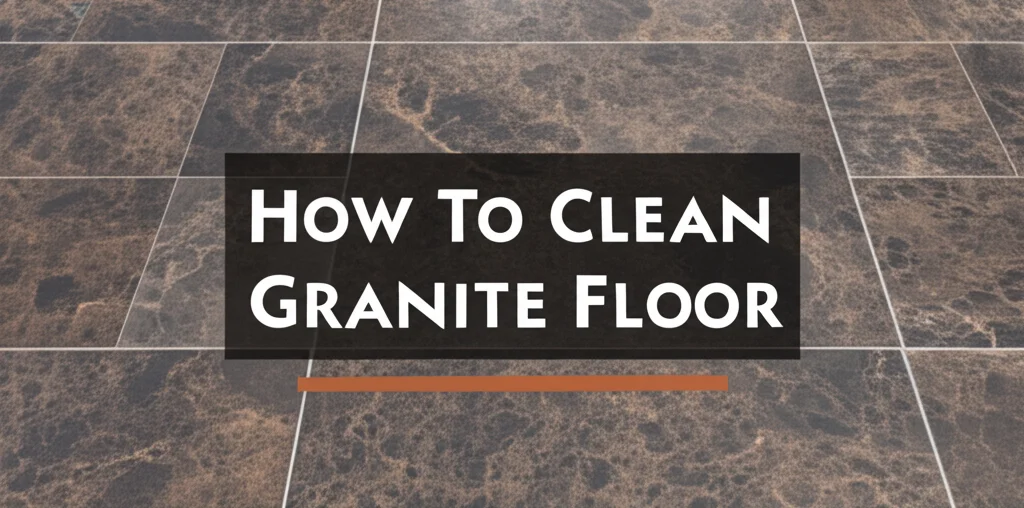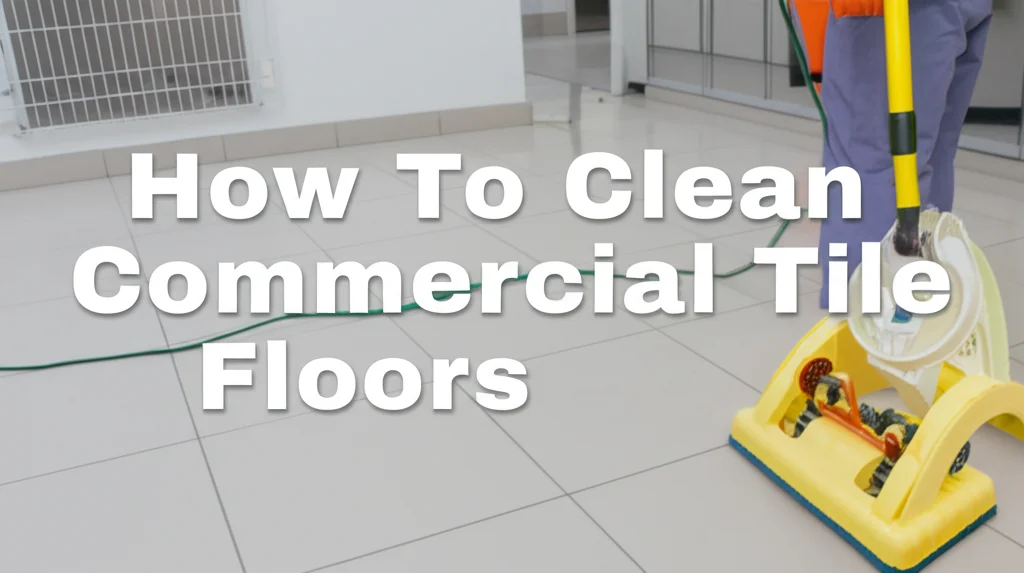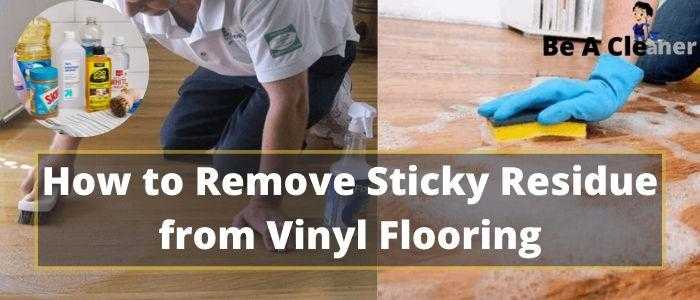· Floor Cleaning · 12 min read
How Do You Clean Granite Floors

How to Clean Granite Floors: The Ultimate Guide
Granite floors bring timeless elegance and durability to any space, but they require proper care to maintain their natural beauty. Knowing how to clean granite floors correctly will protect your investment and keep them looking stunning for decades. This comprehensive guide covers everything from daily cleaning routines to tackling tough stains and polishing techniques for that perfect shine.
Takeaway:
- Use pH-neutral cleaners specifically designed for granite
- Avoid acidic cleaners like vinegar and lemon juice
- Clean spills immediately to prevent staining
- Regular sealing is essential for protecting granite floors
- Microfiber mops and soft cloths are best for cleaning granite
Understanding Your Granite Floors
Granite is a natural stone composed primarily of quartz, feldspar, and mica. This igneous rock is prized for its durability, unique patterns, and luxurious appearance. Before diving into cleaning methods, it’s important to understand what makes granite floors special and why they require specific care.
Granite floors come in two main finishes: polished and honed (also called rough or flamed). Polished granite has a glossy, reflective surface that highlights the stone’s natural beauty but can be slippery when wet. Honed granite offers a matte finish with better traction, making it ideal for high-traffic areas and bathrooms.
Despite granite’s reputation for durability, it’s not indestructible. As a natural stone, granite is porous and can absorb liquids if not properly sealed. This porosity makes it vulnerable to staining, etching, and damage from acidic substances. Understanding these characteristics will help you clean your granite floors effectively without causing damage.
Daily Cleaning Routine for Granite Floors
Keeping your granite floors looking their best requires a consistent cleaning routine. Here’s how to maintain granite floors on a day-to-day basis:
Step 1: Remove loose debris
Start by removing loose dirt and debris that could scratch your granite surface. Use a dust mop with a microfiber head or a soft-bristled broom to gently sweep the floor. Avoid brooms with stiff bristles as they may scratch the surface over time.
For quick cleanup, a vacuum cleaner can be used, but ensure it has a soft floor attachment and no beater bar that could potentially scratch the surface. Always lift the vacuum when moving from one area to another rather than dragging it across the floor.
Step 2: Damp mopping
After removing loose debris, it’s time for a gentle damp mopping:
- Fill a bucket with warm water and add a few drops of pH-neutral stone cleaner specifically formulated for granite.
- Thoroughly wring out your microfiber mop until it’s just damp, not wet.
- Mop in small sections, changing the water when it becomes dirty.
- Avoid excessive water, as standing water can seep into granite and cause damage.
Step 3: Dry completely
Perhaps the most important step in daily granite floor cleaning is thoroughly drying the surface after mopping. Use a soft, clean microfiber cloth to dry the floor, preventing water spots and potential water damage. This extra step helps maintain the floor’s shine and prevents mineral deposits from forming.
How to Clean Granite Floor Stains
Despite your best efforts, stains can happen. The key to successful stain removal is identifying the type of stain and treating it appropriately. Here’s how to tackle common granite floor stains:
Oil-based stains (cooking oil, grease, cosmetics)
Oil-based stains darken the stone and require specific treatment:
- Create a paste using baking soda and water.
- Apply the paste to the stain and cover with plastic wrap.
- Tape down the edges and leave it for 24-48 hours.
- Remove the plastic and rinse thoroughly with clean water.
- Dry completely with a microfiber cloth.
For stubborn oil stains, you may need to repeat this process or use a poultice specifically designed for oil stains on natural stone.
Organic stains (coffee, tea, wine, food)
For organic stains that may discolor your granite floors:
- Blot (don’t rub) the spill immediately with paper towels.
- Clean the area with a pH-neutral stone cleaner.
- For persistent stains, create a hydrogen peroxide poultice (mix 12% hydrogen peroxide with a few drops of ammonia).
- Apply the poultice and cover with plastic wrap for 24 hours.
- Rinse thoroughly and dry completely.
Water spots and hard water deposits
Hard water deposits can leave unsightly marks on granite floors:
- Use a soft, damp cloth with a small amount of pH-neutral stone cleaner.
- Gently buff the affected area.
- For stubborn water spots, use a specialized granite hard water stain remover.
- Always follow up by drying the area completely.
Remember that the sooner you address a spill or stain, the less likely it will become permanent. Always blot spills immediately and clean the area as soon as possible.
How to Clean Rough Granite Floors
Rough or honed granite requires slightly different cleaning approaches due to its textured surface. Here’s how to effectively clean rough granite floors:
- Begin with thorough sweeping or vacuuming to remove dust and debris that can hide in the textured surface.
- Use a slightly more damp mop than you would for polished granite, as the texture can trap more dirt.
- Consider using a soft-bristled brush for periodic deep cleaning to get into the textured areas.
- Rinse well to ensure no cleaner residue remains in the texture.
- Dry thoroughly with absorbent cloths.
For particularly dirty rough granite floors, you might need to use a specialized granite cleaner designed for textured surfaces. These cleaners often have ingredients that can penetrate the uneven surface more effectively.
Regular maintenance is even more crucial for rough granite, as the textured surface can trap more dirt and debris. Consider more frequent cleaning schedules for these floors, especially in high-traffic areas or kitchens where spills are common.
How to Clean Granite Floors Naturally
For those preferring eco-friendly solutions, there are several natural methods to clean granite floors effectively:
Mild dish soap solution
- Add a few drops of mild dish soap to warm water.
- Dampen a microfiber mop and clean in small sections.
- Rinse thoroughly with clean water to remove any soap residue.
- Dry with a soft cloth to prevent streaking.
Alcohol-based solution
For disinfecting granite floors naturally:
- Mix equal parts water and 70% isopropyl alcohol in a spray bottle.
- Lightly spray onto the granite surface.
- Wipe with a microfiber cloth in a circular motion.
- This solution evaporates quickly and won’t leave streaks.
What to avoid
When cleaning granite naturally, avoid these harmful ingredients:
- Vinegar or lemon juice (too acidic and can etch the stone)
- Ammonia-based cleaners (can break down sealants)
- Bleach (damages both the stone and sealant)
- Abrasive cleaners or tools (can scratch the surface)
Using these natural cleaning methods will keep your granite floors looking beautiful while avoiding harsh chemicals. Remember that even with natural cleaners, it’s important to dry the floor thoroughly to prevent water spots and potential water damage.
Polishing Granite Floors at Home
Polishing your granite floors can restore their shine and enhance their natural beauty. Here’s how to polish granite floors at home:
Regular polishing routine
- Thoroughly clean the floor using a pH-neutral granite cleaner.
- Apply a small amount of granite polish to a soft microfiber cloth.
- Work in small sections, applying the polish in a circular motion.
- Allow the polish to dry to a haze (usually 1-2 minutes).
- Buff with a clean, dry microfiber cloth until shiny.
DIY granite polish
You can make a simple DIY granite polish for regular maintenance:
- Mix 3 parts baking soda with 1 part water to create a paste.
- Apply a thin layer to the granite surface.
- Gently buff with a soft cloth in circular motions.
- Rinse thoroughly with clean water.
- Dry completely with a microfiber cloth.
For best results, commercial granite polishes will typically provide a more consistent shine. Look for products specifically formulated for granite floors that both polish and protect.
Professional polishing may be necessary every few years, especially for high-traffic areas that show signs of wear. Professional services can address minor scratches and restore the original luster of your granite floors.
Sealing Granite Floors: A Critical Step
Sealing is perhaps the most important aspect of granite floor maintenance. A quality sealer creates an invisible barrier that prevents liquids and stains from penetrating the stone.
When to seal granite floors
Most granite floors should be sealed every 1-3 years, but the frequency depends on:
- The color and porosity of your specific granite (lighter colors typically need more frequent sealing)
- The amount of traffic the floor receives
- The quality of the sealer used
- Exposure to potential staining agents
How to test if your granite needs sealing
The water drop test is a simple way to determine if your granite needs sealing:
- Place a few drops of water on the granite surface.
- Time how long it takes for the water to absorb (darken the stone).
- If absorption occurs in less than 10 minutes, it’s time to reseal.
- If the water remains beaded after 30 minutes, your seal is still effective.
Sealing process
Follow these steps to seal your granite floors:
- Thoroughly clean the floor and allow it to dry completely (24 hours is ideal).
- Choose a high-quality granite sealer (penetrating sealers are recommended).
- Apply the sealer according to manufacturer’s instructions, typically with a clean microfiber cloth or applicator pad.
- Allow the sealer to penetrate for the recommended time (usually 10-15 minutes).
- Remove excess sealer with a clean, dry cloth before it dries.
- Apply a second coat if recommended by the manufacturer.
- Allow the sealed floor to cure for 24-48 hours before heavy use.
Proper sealing will significantly extend the life and beauty of your granite floors by providing protection against everyday spills and potential stains.
Best Granite Floor Cleaners and Tools
Using the right products and tools is essential for effective granite floor cleaning. Here are some recommendations:
Commercial granite cleaners
Look for cleaners specifically formulated for granite that are:
- pH-neutral
- Non-acidic
- Free from abrasives
- Specially formulated for natural stone
Popular brands include Stone Care International, Method Granite Cleaner, and Black Diamond Stoneworks Granite Cleaner.
Essential cleaning tools
- Microfiber mops and cloths (soft and non-abrasive)
- Soft-bristled brooms
- Vacuum with soft floor attachment
- Spray bottle for homemade solutions
- Soft scrubbing brushes for textured granite
Granite floor cleaning machines
For larger granite floor areas or commercial spaces, consider:
- Low-pressure steam cleaners (ensure they’re suitable for natural stone)
- Floor buffers with non-abrasive pads
- Automatic floor scrubbers with appropriate stone-safe pads
Investing in quality cleaning products and tools specifically designed for granite will help maintain your floors’ beauty and extend their lifespan.
Common Mistakes to Avoid When Cleaning Granite Floors
Avoiding these common mistakes will help preserve your granite floors’ appearance and integrity:
Using acidic cleaners: Vinegar, lemon juice, and other acidic substances can etch granite surfaces.
Applying abrasive tools: Steel wool, scrub brushes, and abrasive pads can scratch and damage the granite surface.
Neglecting to dry: Leaving water standing on granite can lead to water spots and potential damage.
Using all-purpose cleaners: Many contain chemicals harmful to natural stone. Always use granite-specific products.
Forgetting to seal: Regular sealing is essential for protecting granite from stains and damage.
Over-wetting the floor: Excessive water can seep into granite and potentially cause damage.
Dragging heavy objects: Always lift furniture and heavy items rather than dragging them across granite floors.
By avoiding these mistakes, you’ll help ensure your granite floors remain beautiful for many years to come.
FAQ: Granite Floor Cleaning
What is the best thing to clean granite floors with?
The best cleaner for granite floors is a pH-neutral cleaner specifically formulated for natural stone. These cleaners effectively remove dirt and grime without damaging the stone or sealant. For daily cleaning, warm water with a few drops of mild dish soap can also work well, followed by thorough rinsing and drying.
How do you clean granite floors without streaks?
To clean granite floors without streaks, use a microfiber mop with a properly diluted granite cleaner, work in small sections, and—most importantly—dry the floor thoroughly with a clean microfiber cloth immediately after cleaning. Streaks typically form when cleaning solution residue or minerals from water are left to dry on the surface.
Is it OK to clean granite with vinegar and water?
No, it is not recommended to clean granite with vinegar. Vinegar is acidic and can etch, dull, and damage the granite surface by breaking down the protective sealant and potentially the stone itself. Always use pH-neutral cleaners specifically designed for granite and natural stone surfaces.
What is a natural cleaner for granite?
A safe natural cleaner for granite is a mixture of warm water and a few drops of mild dish soap. For disinfecting, a solution of equal parts water and 70% isopropyl alcohol works well without damaging the stone. Avoid natural acidic cleaners like vinegar, lemon juice, or citrus-based products as they can damage granite.
How do you polish a granite floor?
To polish a granite floor, first clean thoroughly with a pH-neutral stone cleaner. Apply a commercial granite polish or sealer with enhancer using a microfiber cloth in a circular motion. Work in small sections, allowing the polish to dry to a haze before buffing with a clean, dry microfiber cloth until shiny.
Does baking soda clean granite?
Baking soda can be used as a poultice for stain removal on granite, but should not be used as a regular cleaner. For stains, make a paste of baking soda and water, apply to the stain, cover with plastic wrap, and leave for 24 hours before rinsing. For routine cleaning, stick to pH-neutral granite cleaners.
Final Words
Maintaining beautiful granite floors doesn’t have to be complicated. By understanding the nature of this luxurious natural stone and following the proper cleaning techniques outlined in this guide, you can preserve your granite floors’ beauty for decades to come. Remember that prevention is key—clean spills promptly, use appropriate cleaners, and maintain a regular sealing schedule.
The investment in proper granite floor care pays dividends in the form of lasting beauty and durability. Whether you have polished or rough granite, light or dark colors, the fundamentals remain the same: gentle cleaning, appropriate products, and consistent maintenance.
For other flooring types in your home, consider checking out our guides on how to clean luxury vinyl plank flooring or how to clean floor grout without scrubbing. If you’re dealing with specific cleaning challenges like removing baking soda residue from carpet or cleaning waterproof laminate floors, we have specialized guides for those situations too.
With the right knowledge and products, your granite floors will continue to be a stunning focal point in your home for years to come.




